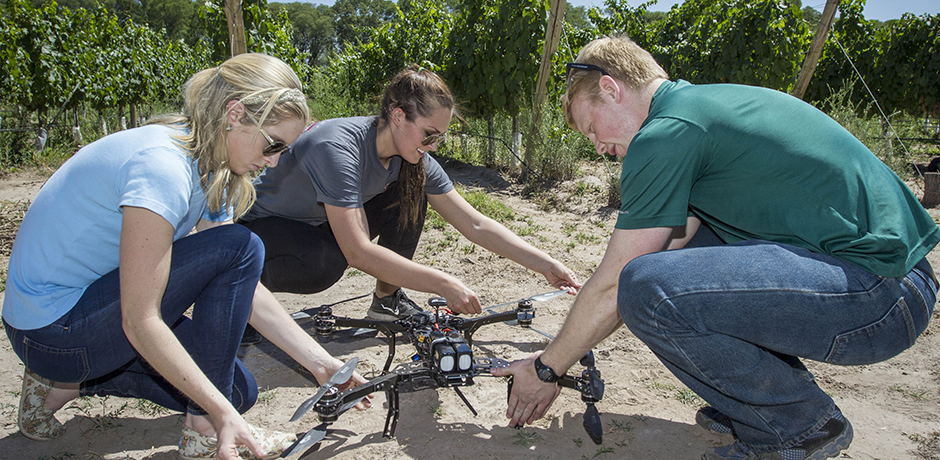Opening the door for future study abroad opportunities, MTSU aerospace and agricultural students flew unmanned aircraft in Mendoza, Argentina, while performing research during winter break.
Along with the five undergraduate students and one alumnus, MTSU faculty members Tony Johnston from the School of Agribusiness and Agriscience and Doug Campbell in the Department of Aerospace teamed up to travel to South America and learn how unmanned aircraft systems — or UAS — can be used in agriculture.

MTSU students Tori Hawkins, left, Megan Knox and Nate Tilton prepare the 3D Robotics X-8 unmanned aircraft next to the grape vineyards at Argentina’s National Institute of Agricultural Technology near Mendoza during winter break. (Photos by Federico Garcia)
Using the 3D Robotics X-8 aircraft, the group studied grape and olive production in Argentina to learn how their award-winning wines and olive oils are produced. They learned the ins-and-outs of making wine and olive oil and brainstormed ideas of how information from the unmanned aircraft, commonly called drones, could help producers increase grape and olive yields and quality.
“The experience was incredibly unique compared to anything I have ever done,” said Aubrey Bloom of Nashville, a junior agriscience major who is earning a minor in aerospace’s unmanned program. “The chance to be a part of this team and the trip was once in a career. It truly reignited my want for research.”
“Argentina was an unforgettable experience that I am proud to say I was part of,” said Jessie McMillin, a senior agribusiness student from Watertown, Tennessee. “It was exciting to finally put all of the skills that I have learned at MTSU to the test. It was also a great cultural experience to see how the people of Argentina lived.”
A flight instructor at the MTSU Department of Aerospace’s Flight Operations Center at Murfreesboro Airport, Nate Tilton, 21, of Brookhaven, Mississippi, “learned a lot about the unmanned aircraft and Argentina, and had an incredible bonding experience with the team.”

MTSU students and faculty prepare the unmanned aircraft for flight at the National Institute of Agricultural Technology near Mendoza, Argentina, during winter break. The research group includes, front row (from left) Jessie McMillin, Tori Hawkins and aerospace UAS coordinator Doug Campbell; and back row (from left) School of Agribusiness and Agriscience professor Tony Johnston and senior aerospace major Nate Tilton.
After learning about current production processes, students worked at Argentina’s National Institute of Agricultural Technology, or INTA, and flew the UAS above experimental grape vineyards and vegetable fields, gathering multispectral images used to determine crop health, Campbell and Johnston said.
The first to ever fly an unmanned aircraft above the Argentina research fields, the students presented their data and accompanying analysis to the institute’s lead agricultural researchers, who were quite pleased and welcomed future student groups, the faculty members said.
The students praised the 3D Robotics X-8 aircraft, which included autopilot and GPS capability that allows autonomous flight. The eight-rotor helicopter carried both a GoPro and multispectral cameras for analyzing the crops.
“The aircraft did an exceptional job during flight,” said Bloom, who suggests the “battery life vs. payload weight needs to be worked on to increase flight time.”
“My first impressions of the X-8 aircraft was pure amazement,” McMillin said. “We did run into some initial calibration issues. Once those were worked out, everything ran smoothly. It was exciting to compare the imaging data we collected with the ground data we collected.”

The 3D Robotics X-8 unmanned aircraft climbs during takeoff at the National Institute of Agricultural Technology, or INTA, near Mendoza, Argentina, as MTSU students and faculty utilized it to collect agricultural research data.
Tilton said the X8 proved to be “a dependable aircraft and performed well despite the hot and dusty conditions. It performed to its specifications and allowed us to capture the information we needed to analyze crop health from the air.”
The students learned to preflight the UAS, program a complex flight plan, fly it from a ground control station, provide backup during takeoffs and landings and process the agricultural images to ultimately produce a better grape crop, said Campbell, unmanned operations manager in aerospace.
Students Tori Hawkins of Murfreesboro and Megan Knox of Nashville and alumna Amanda Williams of Denver, Colorado, also participated.
The Federal Aviation Administration mostly prohibits the commercial use of UAS in the U.S. Campbell added that hobbyists can fly unmanned aircraft as long as they follow a simple set of rules to keep everyone safe, and public entities such as MTSU can fly for research and development purposes through an FAA waiver program.
By traveling to Argentina, MTSU students were able to conduct research they may not have been able to in the U.S. because of FAA restrictions.
Aerospace and the agriculture program plan to conduct the class annually to further strengthen the leadership role MTSU is taking in the use of unmanned aircraft and digital control sensing technologies to improve agricultural output, Campbell said.
— Randy Weiler (Randy.Weiler@mtsu.edu)

With rows of grapevines in the background, MTSU students and faculty members are shown after a day of flying the 3D Robotics X-8 unmanned aircraft at Argentina’s National Institute of Agricultural Technology near Mendoza. The group includes (from left) Aubrey Bloom, Megan Knox, Amanda Williams, Tony Johnston, Jessie McMillin, Tori Hawkins, Doug Campbell and Nate Tilton.


COMMENTS ARE OFF THIS POST